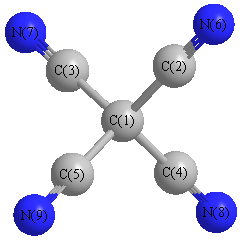Vibrational Frequencies calculated at MP2/6-31G
| Mode Number |
Symmetry |
Frequency
(cm-1) |
Scaled Frequency
(cm-1) |
IR Intensities
(km mol-1) |
Raman Act
(Å4/u) |
Dep P |
Dep U |
|---|
| 1 |
A1 |
2060 |
1971 |
0.00 |
|
|
|
| 2 |
A1 |
564 |
539 |
0.00 |
|
|
|
| 3 |
E |
522 |
499 |
0.00 |
|
|
|
| 3 |
E |
522 |
499 |
0.00 |
|
|
|
| 4 |
E |
104 |
100 |
0.00 |
|
|
|
| 4 |
E |
104 |
100 |
0.00 |
|
|
|
| 5 |
T1 |
301 |
288 |
0.00 |
|
|
|
| 5 |
T1 |
301 |
288 |
0.00 |
|
|
|
| 5 |
T1 |
301 |
288 |
0.00 |
|
|
|
| 6 |
T2 |
2064 |
1975 |
30.97 |
|
|
|
| 6 |
T2 |
2064 |
1975 |
30.97 |
|
|
|
| 6 |
T2 |
2064 |
1975 |
30.97 |
|
|
|
| 7 |
T2 |
1031 |
986 |
31.88 |
|
|
|
| 7 |
T2 |
1031 |
986 |
31.88 |
|
|
|
| 7 |
T2 |
1031 |
986 |
31.88 |
|
|
|
| 8 |
T2 |
537 |
514 |
1.05 |
|
|
|
| 8 |
T2 |
537 |
514 |
1.05 |
|
|
|
| 8 |
T2 |
537 |
514 |
1.05 |
|
|
|
| 9 |
T2 |
135 |
129 |
10.39 |
|
|
|
| 9 |
T2 |
135 |
129 |
10.39 |
|
|
|
| 9 |
T2 |
135 |
129 |
10.39 |
|
|
|
Unscaled Zero Point Vibrational Energy (zpe) 8040.1 cm
-1
Scaled (by 0.9568) Zero Point Vibrational Energy (zpe) 7692.8 cm
-1
See section
III.C.1 List or set vibrational scaling factors
to change the scale factors used here.
See section
III.C.2
Calculate a vibrational scaling factor for a given set of molecules
to determine the least squares best scaling factor.
